The growth of the UCI Libraries East Asian Collection expanded to include a range of formats, subjects, geographic areas and time periods. Over the years, with continued generous support from the UCI Libraries administration and UCI faculty and community partners, the collection acquired rich resources in modern East Asian literature and history and Chinese classics, including rare items for scholars around the world to use.
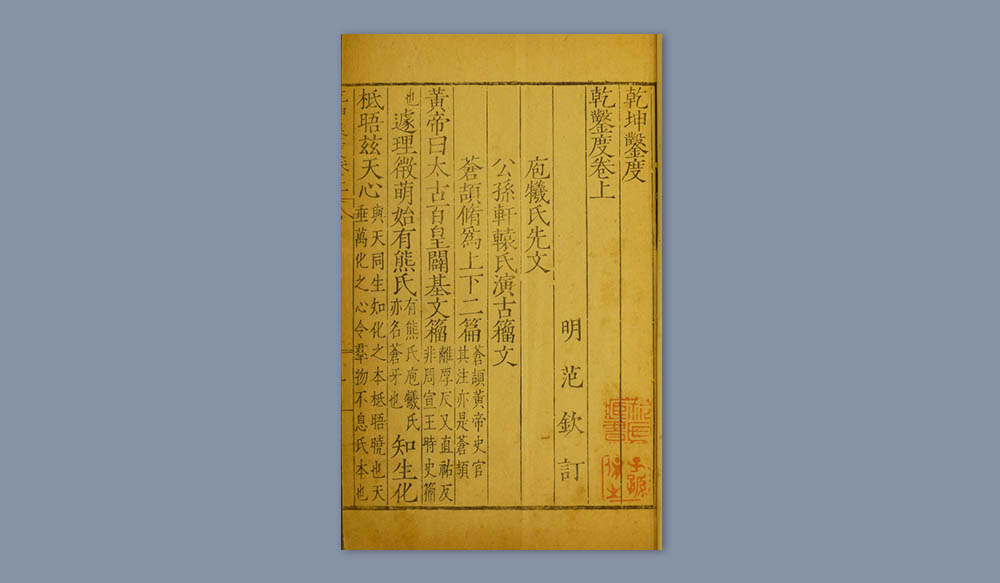
13. Cang, Jie and Fan, Qin. 乾坤鑿度 Qian Kun Zao Du (Connecting Earth and Heaven or Yin and Yang). China. Tian Yi Ge. 1522. UCI Libraries’ Special Collections and Archives.
Original texts are believed to be written by Cang Jie (蒼頡), a legendary figure from ancient China, circa 2650 BC, who invented Chinese characters. These texts were printed with woodblocks by Tian Yi Ge (Pavilion of Cosmic Unity), the oldest existing library in China, and was edited by Fan Qin (范欽), a politician and bibliophile of China’s Ming Dynasty (1368-1644). Fan Qin was also the founder and owner of the Pavilion of Cosmic Unity.
This early 16th century Chinese printing of Qian Kun Zao Du (Connecting Earth and Heaven or Yin and Yang) is one of the oldest publications held by the UCI Libraries' Special Collections and Archives.

14. Sima, Qian. 史記鈔 Shi Ji Chao (The Records of the Grand Historian of China). Unknown Publisher. 1574. UCI Libraries’ Special Collections and Archives. (Image 1 of 6)
This book was written by Sima Tan and later finished by his son Sima Qian. Both father and son served as Court Astrologers (Tai Shi) in China’s Western Han Dynasty (202 BC-25 AD). They were responsible for making astronomical observations and drafting annual lunisolar calendars. Their court positions granted them easy access to the Imperial Library for early Chinese historical documents.
The copy held by the UCI Libraries, donated by Robert B. Booney, was originally printed using an advanced woodblock printing technique. The main body was printed in black ink while notes, commentaries, underlines and punctuations were in red ink.
Some 300 years after this copy was published, a beautiful fore-edge painting was added by Lu Hongnian (陸鴻年), a renowned Chinese artist. The painting is of Jesus in a traditional Chinese Han outfit with bound hands. This kind of fore-edge painting was a commercialized practice popular in China in the late 19th century and first half of the 20th century transforming an ancient Chinese book into a collectible art piece attractive to Western visitors.

14. Sima, Qian. 史記鈔 Shi Ji Chao (The Records of the Grand Historian of China). Unknown Publisher. 1574. UCI Libraries’ Special Collections and Archives. (Image 2 of 6)
This book was written by Sima Tan and later finished by his son Sima Qian. Both father and son served as Court Astrologers (Tai Shi) in China’s Western Han Dynasty (202 BC-25 AD). They were responsible for making astronomical observations and drafting annual lunisolar calendars. Their court positions granted them easy access to the Imperial Library for early Chinese historical documents.
The copy held by the UCI Libraries, donated by Robert B. Booney, was originally printed using an advanced woodblock printing technique. The main body was printed in black ink while notes, commentaries, underlines and punctuations were in red ink.
Some 300 years after this copy was published, a beautiful fore-edge painting was added by Lu Hongnian (陸鴻年), a renowned Chinese artist. The painting is of Jesus in a traditional Chinese Han outfit with bound hands. This kind of fore-edge painting was a commercialized practice popular in China in the late 19th century and first half of the 20th century transforming an ancient Chinese book into a collectible art piece attractive to Western visitors.

14. Sima, Qian. 史記鈔 Shi Ji Chao (The Records of the Grand Historian of China). Unknown Publisher. 1574. UCI Libraries’ Special Collections and Archives. (Image 3 of 6)
This book was written by Sima Tan and later finished by his son Sima Qian. Both father and son served as Court Astrologers (Tai Shi) in China’s Western Han Dynasty (202 BC-25 AD). They were responsible for making astronomical observations and drafting annual lunisolar calendars. Their court positions granted them easy access to the Imperial Library for early Chinese historical documents.
The copy held by the UCI Libraries, donated by Robert B. Booney, was originally printed using an advanced woodblock printing technique. The main body was printed in black ink while notes, commentaries, underlines and punctuations were in red ink.
Some 300 years after this copy was published, a beautiful fore-edge painting was added by Lu Hongnian (陸鴻年), a renowned Chinese artist. The painting is of Jesus in a traditional Chinese Han outfit with bound hands. This kind of fore-edge painting was a commercialized practice popular in China in the late 19th century and first half of the 20th century transforming an ancient Chinese book into a collectible art piece attractive to Western visitors.
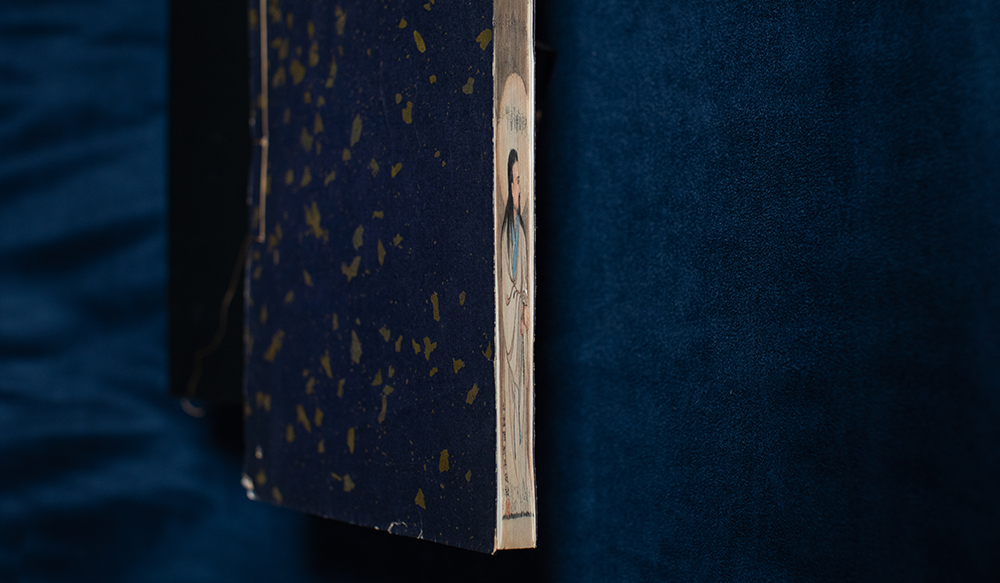
14. Sima, Qian. 史記鈔 Shi Ji Chao (The Records of the Grand Historian of China). Unknown Publisher. 1574. UCI Libraries’ Special Collections and Archives. (Image 4 of 6)
This book was written by Sima Tan and later finished by his son Sima Qian. Both father and son served as Court Astrologers (Tai Shi) in China’s Western Han Dynasty (202 BC-25 AD). They were responsible for making astronomical observations and drafting annual lunisolar calendars. Their court positions granted them easy access to the Imperial Library for early Chinese historical documents.
The copy held by the UCI Libraries, donated by Robert B. Booney, was originally printed using an advanced woodblock printing technique. The main body was printed in black ink while notes, commentaries, underlines and punctuations were in red ink.
Some 300 years after this copy was published, a beautiful fore-edge painting was added by Lu Hongnian (陸鴻年), a renowned Chinese artist. The painting is of Jesus in a traditional Chinese Han outfit with bound hands. This kind of fore-edge painting was a commercialized practice popular in China in the late 19th century and first half of the 20th century transforming an ancient Chinese book into a collectible art piece attractive to Western visitors.
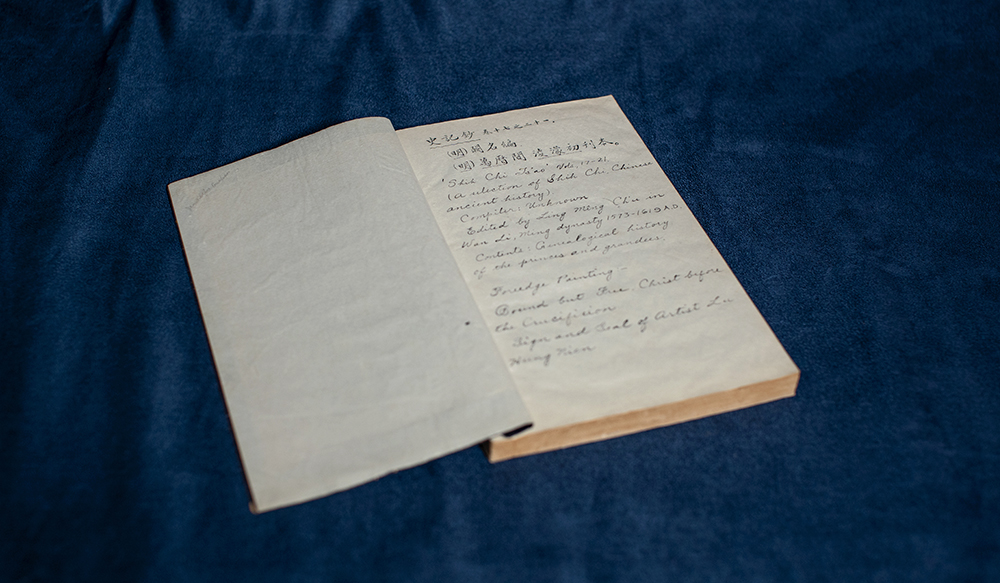
14. Sima, Qian. 史記鈔 Shi Ji Chao (The Records of the Grand Historian of China). Unknown Publisher. 1574. UCI Libraries’ Special Collections and Archives. (Image 5 of 6)
This book was written by Sima Tan and later finished by his son Sima Qian. Both father and son served as Court Astrologers (Tai Shi) in China’s Western Han Dynasty (202 BC-25 AD). They were responsible for making astronomical observations and drafting annual lunisolar calendars. Their court positions granted them easy access to the Imperial Library for early Chinese historical documents.
The copy held by the UCI Libraries, donated by Robert B. Booney, was originally printed using an advanced woodblock printing technique. The main body was printed in black ink while notes, commentaries, underlines and punctuations were in red ink.
Some 300 years after this copy was published, a beautiful fore-edge painting was added by Lu Hongnian (陸鴻年), a renowned Chinese artist. The painting is of Jesus in a traditional Chinese Han outfit with bound hands. This kind of fore-edge painting was a commercialized practice popular in China in the late 19th century and first half of the 20th century transforming an ancient Chinese book into a collectible art piece attractive to Western visitors.
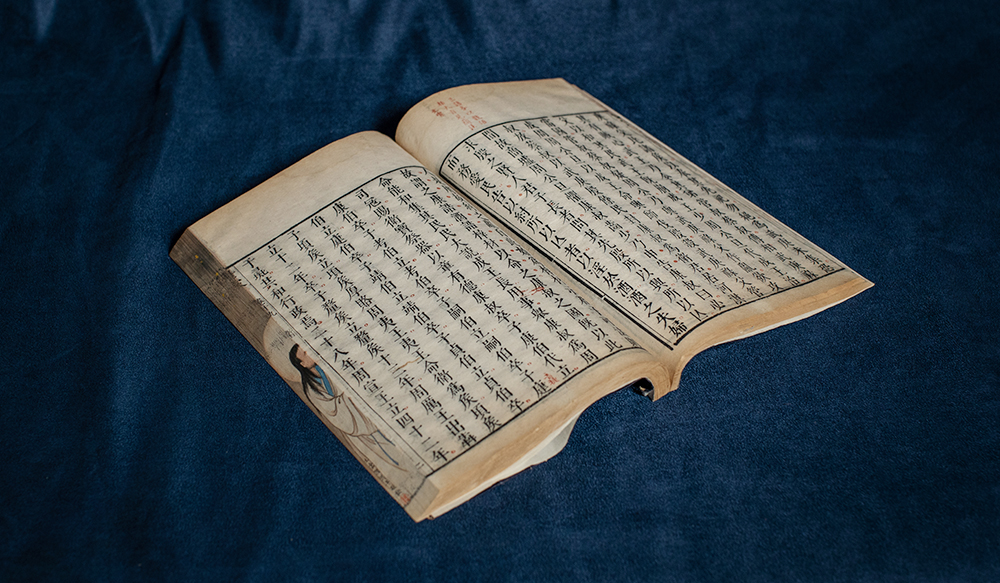
14. Sima, Qian. 史記鈔 Shi Ji Chao (The Records of the Grand Historian of China). Unknown Publisher. 1574. UCI Libraries’ Special Collections and Archives. (Image 6 of 6)
This book was written by Sima Tan and later finished by his son Sima Qian. Both father and son served as Court Astrologers (Tai Shi) in China’s Western Han Dynasty (202 BC-25 AD). They were responsible for making astronomical observations and drafting annual lunisolar calendars. Their court positions granted them easy access to the Imperial Library for early Chinese historical documents.
The copy held by the UCI Libraries, donated by Robert B. Booney, was originally printed using an advanced woodblock printing technique. The main body was printed in black ink while notes, commentaries, underlines and punctuations were in red ink.
Some 300 years after this copy was published, a beautiful fore-edge painting was added by Lu Hongnian (陸鴻年), a renowned Chinese artist. The painting is of Jesus in a traditional Chinese Han outfit with bound hands. This kind of fore-edge painting was a commercialized practice popular in China in the late 19th century and first half of the 20th century transforming an ancient Chinese book into a collectible art piece attractive to Western visitors.
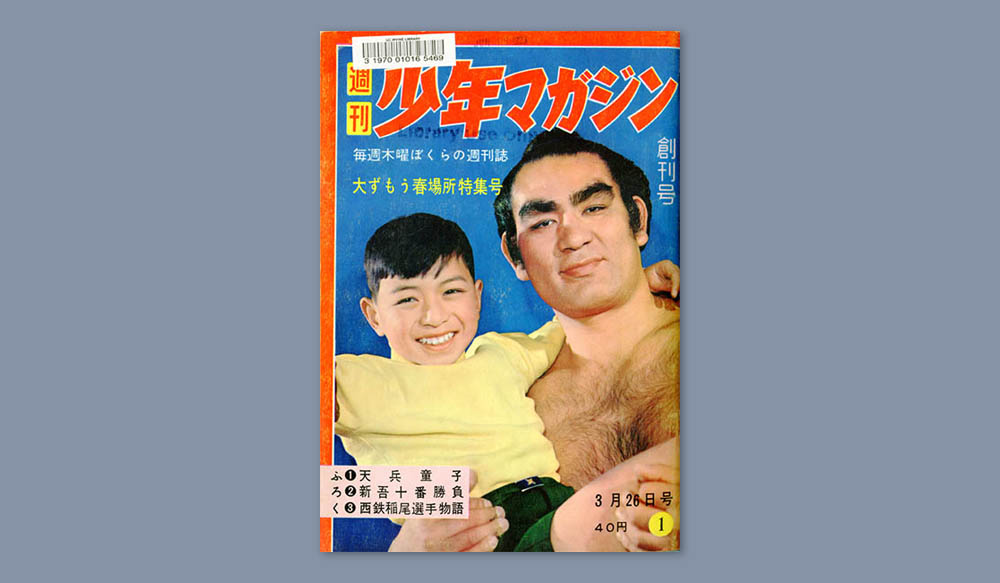
15. 週刊少年マガジン Shūkan Shōnen Magajin. Tokyo. Kōdansha. 1959-Present.
Shūkan Shōnen Magajin (Weekly Youth Magazine) is a popular Japanese youth manga (comic) anthology. Donated by Mrs. Sawako Noma, the publishing company owner, it is the most complete holdings in North America covering a span of 36 years from the very first issue published on March 26, 1959 to issues from its peak publication era in the mid-1990s.
a. The inaugural issue features a photo of sumo wrestler Asashio Tarō III 朝潮太郎 on the cover.
週刊少年マガジン Shūkan Shōnen Magajin. Tokyo. Kōdansha. 1959-Present. Issue Number 1. 1959.
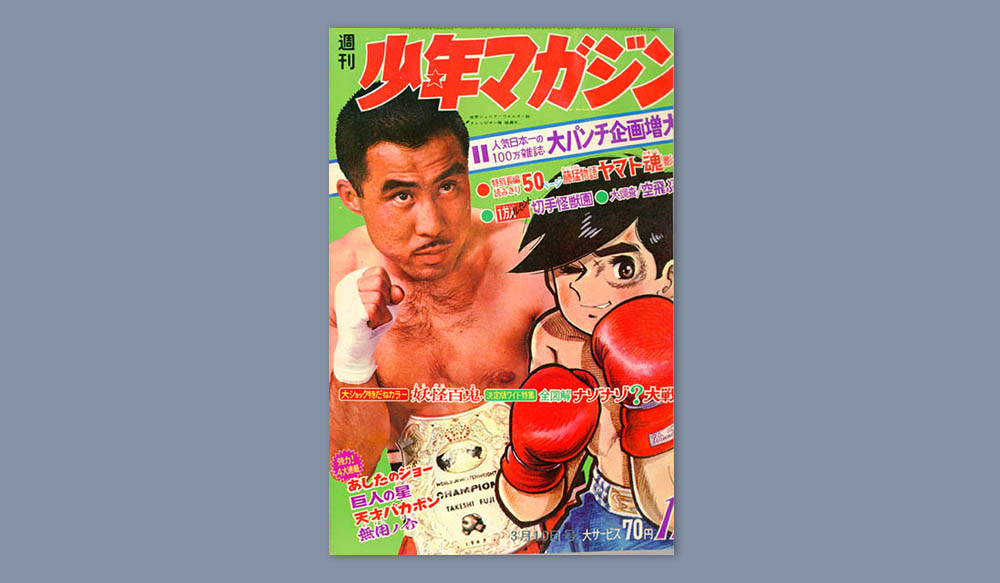
15. 週刊少年マガジン Shūkan Shōnen Magajin. Tokyo. Kōdansha. 1959-Present.
b. The issue features the boxing manga story あしたのジョー Ashita no Joe (Tomorrow’s Joe) by Kajiwara Ikki on Pages 27-41. The cover page shows main comic character Joe with Takeshi Fuji, a Hawaiian-born Japanese professional boxer, in the background.
The boxing manga series, published in Shūkan Shōnen Magajin from 1968 to 1973, follows Joe Yubkui, a troubled young man, who ran away from an orphanage, struggled to live and fought until death.
週刊少年マガジン Shūkan Shōnen Magajin. Tokyo. Kōdansha. 1959-Present. Issue Number 11. 1968.

15. 週刊少年マガジン Shūkan Shōnen Magajin. Tokyo. Kōdansha. 1959-Present.
b. The issue features the boxing manga story あしたのジョー Ashita no Joe (Tomorrow’s Joe) by Kajiwara Ikki on Pages 27-41. The cover page shows main comic character Joe with Takeshi Fuji, a Hawaiian-born Japanese professional boxer, in the background.
The boxing manga series, published in Shūkan Shōnen Magajin from 1968 to 1973, follows Joe Yubkui, a troubled young man, who ran away from an orphanage, struggled to live and fought until death.
週刊少年マガジン Shūkan Shōnen Magajin. Tokyo. Kōdansha. 1959-Present. Issue Number 11. 1968.
The manga story has been adapted to:
i. A 79-episode anime television series. The UCI Libraries owns a DVD of a compilation of scenes from the TV series originally produced as a motion picture in 1970. Takamori, Asao et al. Tomorrow’s Joe. DiscoTek Media. 2017.

13. Cang, Jie and Fan, Qin. 乾坤鑿度 Qian Kun Zao Du (Connecting Earth and Heaven or Yin and Yang). China. Tian Yi Ge. 1522. UCI Libraries’ Special Collections and Archives.
Original texts are believed to be written by Cang Jie (蒼頡), a legendary figure from ancient China, circa 2650 BC, who invented Chinese characters. These texts were printed with woodblocks by Tian Yi Ge (Pavilion of Cosmic Unity), the oldest existing library in China, and was edited by Fan Qin (范欽), a politician and bibliophile of China’s Ming Dynasty (1368-1644). Fan Qin was also the founder and owner of the Pavilion of Cosmic Unity.
This early 16th century Chinese printing of Qian Kun Zao Du (Connecting Earth and Heaven or Yin and Yang) is one of the oldest publications held by the UCI Libraries' Special Collections and Archives.

14. Sima, Qian. 史記鈔 Shi Ji Chao (The Records of the Grand Historian of China). Unknown Publisher. 1574. UCI Libraries’ Special Collections and Archives. (Image 1 of 6)
This book was written by Sima Tan and later finished by his son Sima Qian. Both father and son served as Court Astrologers (Tai Shi) in China’s Western Han Dynasty (202 BC-25 AD). They were responsible for making astronomical observations and drafting annual lunisolar calendars. Their court positions granted them easy access to the Imperial Library for early Chinese historical documents.
The copy held by the UCI Libraries, donated by Robert B. Booney, was originally printed using an advanced woodblock printing technique. The main body was printed in black ink while notes, commentaries, underlines and punctuations were in red ink.
Some 300 years after this copy was published, a beautiful fore-edge painting was added by Lu Hongnian (陸鴻年), a renowned Chinese artist. The painting is of Jesus in a traditional Chinese Han outfit with bound hands. This kind of fore-edge painting was a commercialized practice popular in China in the late 19th century and first half of the 20th century transforming an ancient Chinese book into a collectible art piece attractive to Western visitors.

14. Sima, Qian. 史記鈔 Shi Ji Chao (The Records of the Grand Historian of China). Unknown Publisher. 1574. UCI Libraries’ Special Collections and Archives. (Image 2 of 6)
This book was written by Sima Tan and later finished by his son Sima Qian. Both father and son served as Court Astrologers (Tai Shi) in China’s Western Han Dynasty (202 BC-25 AD). They were responsible for making astronomical observations and drafting annual lunisolar calendars. Their court positions granted them easy access to the Imperial Library for early Chinese historical documents.
The copy held by the UCI Libraries, donated by Robert B. Booney, was originally printed using an advanced woodblock printing technique. The main body was printed in black ink while notes, commentaries, underlines and punctuations were in red ink.
Some 300 years after this copy was published, a beautiful fore-edge painting was added by Lu Hongnian (陸鴻年), a renowned Chinese artist. The painting is of Jesus in a traditional Chinese Han outfit with bound hands. This kind of fore-edge painting was a commercialized practice popular in China in the late 19th century and first half of the 20th century transforming an ancient Chinese book into a collectible art piece attractive to Western visitors.

14. Sima, Qian. 史記鈔 Shi Ji Chao (The Records of the Grand Historian of China). Unknown Publisher. 1574. UCI Libraries’ Special Collections and Archives. (Image 3 of 6)
This book was written by Sima Tan and later finished by his son Sima Qian. Both father and son served as Court Astrologers (Tai Shi) in China’s Western Han Dynasty (202 BC-25 AD). They were responsible for making astronomical observations and drafting annual lunisolar calendars. Their court positions granted them easy access to the Imperial Library for early Chinese historical documents.
The copy held by the UCI Libraries, donated by Robert B. Booney, was originally printed using an advanced woodblock printing technique. The main body was printed in black ink while notes, commentaries, underlines and punctuations were in red ink.
Some 300 years after this copy was published, a beautiful fore-edge painting was added by Lu Hongnian (陸鴻年), a renowned Chinese artist. The painting is of Jesus in a traditional Chinese Han outfit with bound hands. This kind of fore-edge painting was a commercialized practice popular in China in the late 19th century and first half of the 20th century transforming an ancient Chinese book into a collectible art piece attractive to Western visitors.

14. Sima, Qian. 史記鈔 Shi Ji Chao (The Records of the Grand Historian of China). Unknown Publisher. 1574. UCI Libraries’ Special Collections and Archives. (Image 4 of 6)
This book was written by Sima Tan and later finished by his son Sima Qian. Both father and son served as Court Astrologers (Tai Shi) in China’s Western Han Dynasty (202 BC-25 AD). They were responsible for making astronomical observations and drafting annual lunisolar calendars. Their court positions granted them easy access to the Imperial Library for early Chinese historical documents.
The copy held by the UCI Libraries, donated by Robert B. Booney, was originally printed using an advanced woodblock printing technique. The main body was printed in black ink while notes, commentaries, underlines and punctuations were in red ink.
Some 300 years after this copy was published, a beautiful fore-edge painting was added by Lu Hongnian (陸鴻年), a renowned Chinese artist. The painting is of Jesus in a traditional Chinese Han outfit with bound hands. This kind of fore-edge painting was a commercialized practice popular in China in the late 19th century and first half of the 20th century transforming an ancient Chinese book into a collectible art piece attractive to Western visitors.

14. Sima, Qian. 史記鈔 Shi Ji Chao (The Records of the Grand Historian of China). Unknown Publisher. 1574. UCI Libraries’ Special Collections and Archives. (Image 5 of 6)
This book was written by Sima Tan and later finished by his son Sima Qian. Both father and son served as Court Astrologers (Tai Shi) in China’s Western Han Dynasty (202 BC-25 AD). They were responsible for making astronomical observations and drafting annual lunisolar calendars. Their court positions granted them easy access to the Imperial Library for early Chinese historical documents.
The copy held by the UCI Libraries, donated by Robert B. Booney, was originally printed using an advanced woodblock printing technique. The main body was printed in black ink while notes, commentaries, underlines and punctuations were in red ink.
Some 300 years after this copy was published, a beautiful fore-edge painting was added by Lu Hongnian (陸鴻年), a renowned Chinese artist. The painting is of Jesus in a traditional Chinese Han outfit with bound hands. This kind of fore-edge painting was a commercialized practice popular in China in the late 19th century and first half of the 20th century transforming an ancient Chinese book into a collectible art piece attractive to Western visitors.

14. Sima, Qian. 史記鈔 Shi Ji Chao (The Records of the Grand Historian of China). Unknown Publisher. 1574. UCI Libraries’ Special Collections and Archives. (Image 6 of 6)
This book was written by Sima Tan and later finished by his son Sima Qian. Both father and son served as Court Astrologers (Tai Shi) in China’s Western Han Dynasty (202 BC-25 AD). They were responsible for making astronomical observations and drafting annual lunisolar calendars. Their court positions granted them easy access to the Imperial Library for early Chinese historical documents.
The copy held by the UCI Libraries, donated by Robert B. Booney, was originally printed using an advanced woodblock printing technique. The main body was printed in black ink while notes, commentaries, underlines and punctuations were in red ink.
Some 300 years after this copy was published, a beautiful fore-edge painting was added by Lu Hongnian (陸鴻年), a renowned Chinese artist. The painting is of Jesus in a traditional Chinese Han outfit with bound hands. This kind of fore-edge painting was a commercialized practice popular in China in the late 19th century and first half of the 20th century transforming an ancient Chinese book into a collectible art piece attractive to Western visitors.

15. 週刊少年マガジン Shūkan Shōnen Magajin. Tokyo. Kōdansha. 1959-Present.
Shūkan Shōnen Magajin (Weekly Youth Magazine) is a popular Japanese youth manga (comic) anthology. Donated by Mrs. Sawako Noma, the publishing company owner, it is the most complete holdings in North America covering a span of 36 years from the very first issue published on March 26, 1959 to issues from its peak publication era in the mid-1990s.
a. The inaugural issue features a photo of sumo wrestler Asashio Tarō III 朝潮太郎 on the cover.
週刊少年マガジン Shūkan Shōnen Magajin. Tokyo. Kōdansha. 1959-Present. Issue Number 1. 1959.

15. 週刊少年マガジン Shūkan Shōnen Magajin. Tokyo. Kōdansha. 1959-Present.
b. The issue features the boxing manga story あしたのジョー Ashita no Joe (Tomorrow’s Joe) by Kajiwara Ikki on Pages 27-41. The cover page shows main comic character Joe with Takeshi Fuji, a Hawaiian-born Japanese professional boxer, in the background.
The boxing manga series, published in Shūkan Shōnen Magajin from 1968 to 1973, follows Joe Yubkui, a troubled young man, who ran away from an orphanage, struggled to live and fought until death.
週刊少年マガジン Shūkan Shōnen Magajin. Tokyo. Kōdansha. 1959-Present. Issue Number 11. 1968.

15. 週刊少年マガジン Shūkan Shōnen Magajin. Tokyo. Kōdansha. 1959-Present.
b. The issue features the boxing manga story あしたのジョー Ashita no Joe (Tomorrow’s Joe) by Kajiwara Ikki on Pages 27-41. The cover page shows main comic character Joe with Takeshi Fuji, a Hawaiian-born Japanese professional boxer, in the background.
The boxing manga series, published in Shūkan Shōnen Magajin from 1968 to 1973, follows Joe Yubkui, a troubled young man, who ran away from an orphanage, struggled to live and fought until death.
週刊少年マガジン Shūkan Shōnen Magajin. Tokyo. Kōdansha. 1959-Present. Issue Number 11. 1968.
The manga story has been adapted to:
i. A 79-episode anime television series. The UCI Libraries owns a DVD of a compilation of scenes from the TV series originally produced as a motion picture in 1970. Takamori, Asao et al. Tomorrow’s Joe. DiscoTek Media. 2017.
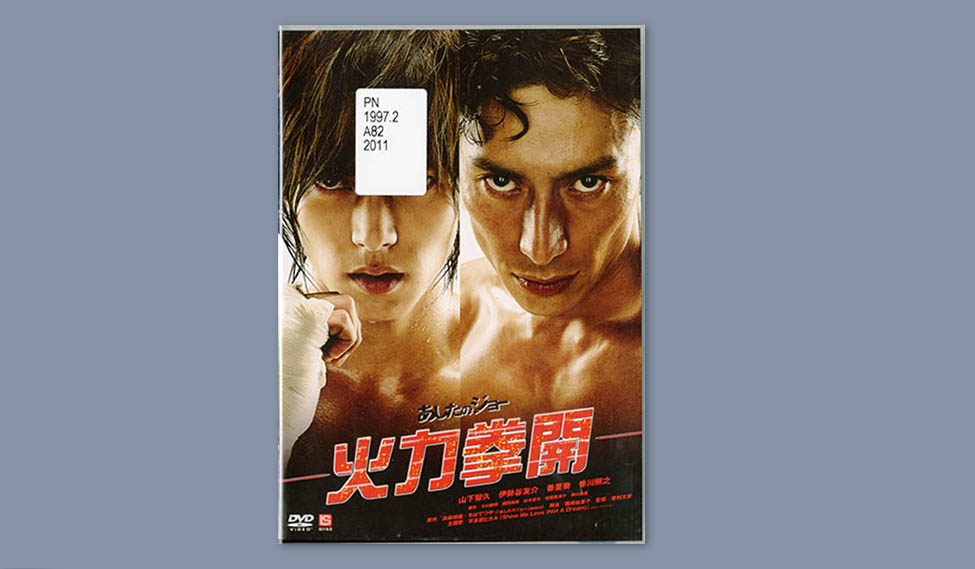
15. 週刊少年マガジン Shūkan Shōnen Magajin. Tokyo. Kōdansha. 1959-Present.
b. The issue features the boxing manga story あしたのジョー Ashita no Joe (Tomorrow’s Joe) by Kajiwara Ikki on Pages 27-41. The cover page shows main comic character Joe with Takeshi Fuji, a Hawaiian-born Japanese professional boxer, in the background.
The boxing manga series, published in Shūkan Shōnen Magajin from 1968 to 1973, follows Joe Yubkui, a troubled young man, who ran away from an orphanage, struggled to live and fought until death.
週刊少年マガジン Shūkan Shōnen Magajin. Tokyo. Kōdansha. 1959-Present. Issue Number 11. 1968.
The manga story has been adapted to:
ii. A feature film directed by Sori Fumihiko in 2011.
Sori, Fumihiko. Ashita no Joe. Taiwan: Long Shong Group. 2011.
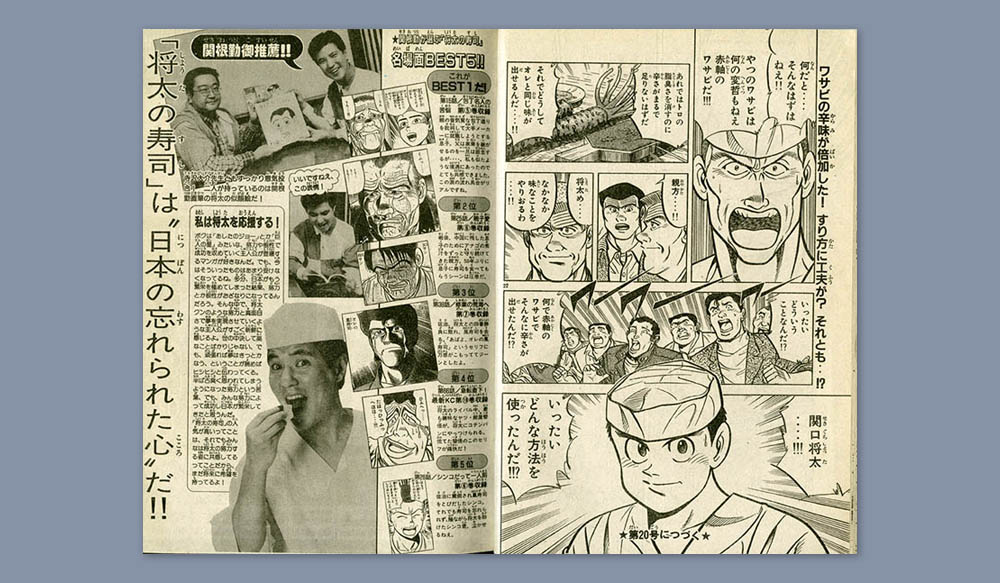
15. 週刊少年マガジン Shūkan Shōnen Magajin. Tokyo. Kōdansha. 1959-Present.
c. The issue features the sushi manga story 将太の寿司 Shota no Sushi by Terasawa Daisuke on Pages 19-41. This sushi manga series ran from 1992 to 1997 in Shūkan Shōnen Magajin. The story is about a teen boy, Sekiguchi Shota, and his tough journey from an apprentice to a sushi chef. An important part of the story is an attempt to save his family-operated sushi shop from being taken over by a fast-growing sushi chain business. The manga series became very popular and later adapted into a television series.
Page 41 also features commentary by Tsutomu Sekine, a renowned Japanese comedian, singer and television host, and fan of the Sushi manga series Shota no Sushi.
In his commentary, Tsutomu highly recommends the manga story and urges people to work as diligently as fictional character Shota, so Japan regains its economic strength.
週刊少年マガジンShūkan Shōnen Magajin. Tokyo. Kōdansha. 1959-Present. Issue Number 19. 1994. Page 40-41.
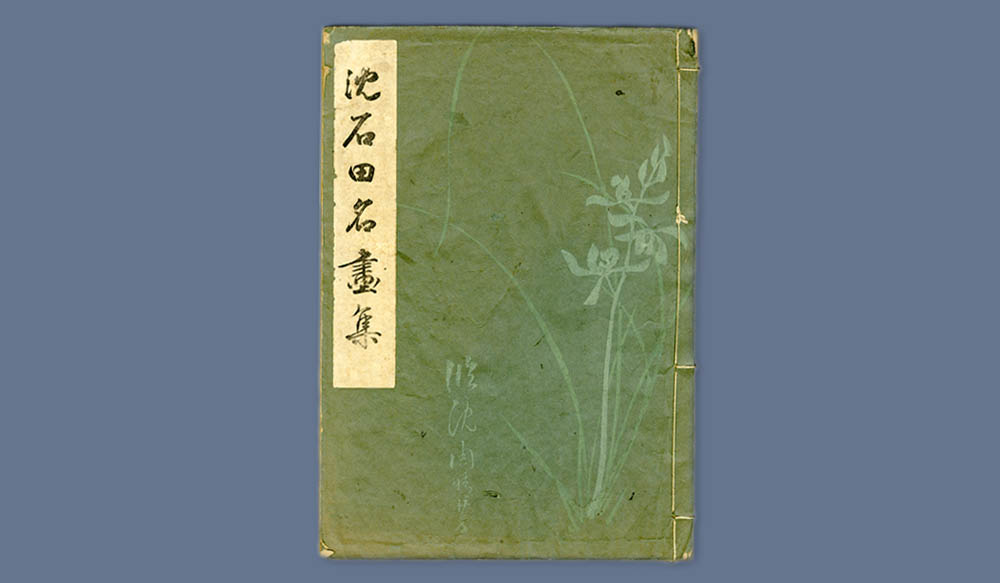
16. Shen, Zhou. 沈石田名畫集 Chin Sekiden Meigashū. Japan. Unknown Publisher. 1930-1950. UCI Libraries’ Special Collections and Archives.
This Japanese anthology of masterpieces by Chinese artist Shen Zhou is one of two copies in North America. Shen Zhou, a Ming Dynasty painter who lived from 1427-1509, contributed greatly to the art tradition of China. He was a founding artist of the Wu School of painting, which is characterized by inscriptions describing, when, how and why the painting is created.
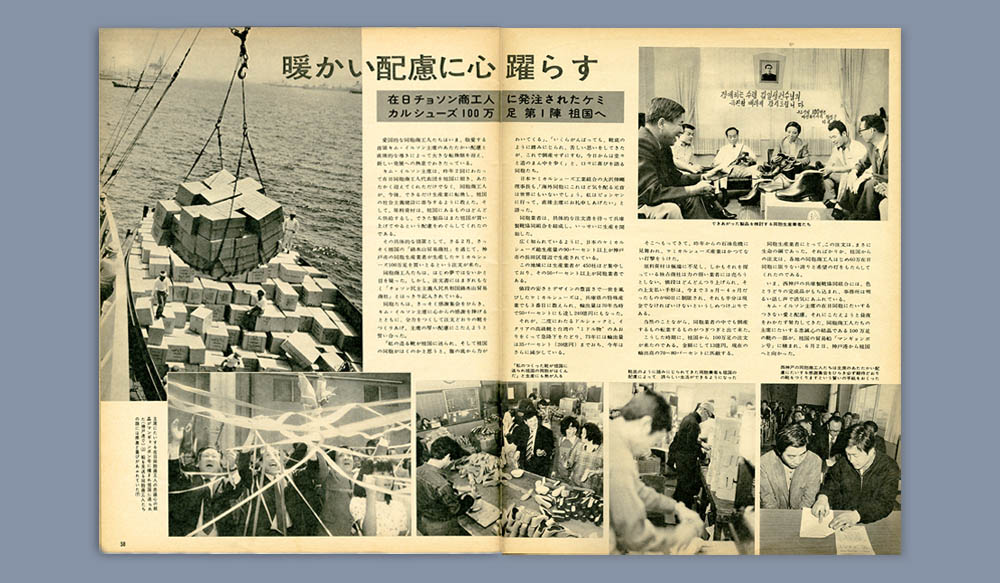
17. 朝鮮画報 Chōsen Gahō (The Korean Pictorial). Tōkyō. Chōsen Gahōsha. 1962-Present. UCI Libraries’ Special Collections and Archives.
Published in Tokyo in Japanese language by Zainichi Chōsenjin (North Korean Japanese), Chōsen Gahō is a monthly pictorial magazine, documenting lives of North Korean immigrants in Japan and their connection to the motherland. The UCI Libraries owns this unique and valuable resource thanks to a generous donation from Sarah Lee, a UCI alumna and Irvine, California resident. On display are two selected issues from UCI Libraries Special Collection and Archives. Special Collections and Archives holds issues between Number 3 published in 1964 and Number 6 published in 1981, though some issues are missing.
a. The issue of Chōsen Gahō features the story of a North Korean businessman in Japan who sent 1,000,000 pairs of shoes back to his motherland.
朝鮮画報 Chōsen Gahō (The Korean Pictorial). Tōkyō. Chōsen Gahōsha. 1962-. Issue Number 7. 1974. Pages 50-51.
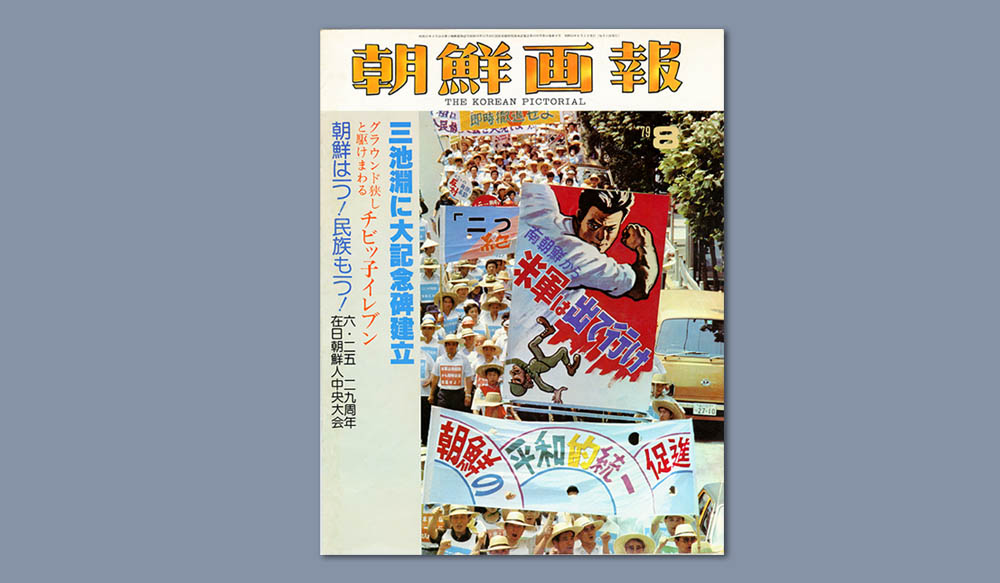
17. 朝鮮画報 Chōsen Gahō (The Korean Pictorial). Tōkyō. Chōsen Gahōsha. 1962-Present. UCI Libraries’ Special Collections and Archives.
Published in Tokyo in Japanese language by Zainichi Chōsenjin (North Korean Japanese), Chōsen Gahō is a monthly pictorial magazine, documenting lives of North Korean immigrants in Japan and their connection to the motherland. The UCI Libraries owns this unique and valuable resource thanks to a generous donation from Sarah Lee, a UCI alumna and Irvine, California resident. On display are two selected issues from UCI Libraries Special Collection and Archives. Special Collections and Archives holds issues between Number 3 published in 1964 and Number 6 published in 1981, though some issues
b. The cover page of this issue of Chōsen Gahō depicts the Central Congress of All North Korean Japanese held on Jun 25, 1978. The banner in the front reads 朝鮮の平和的統一促進 (Advancing Peaceful Unification of Two Koreas). The text on the poster says 南朝鮮から美軍は出て行け (Get Out from South Korea, the U.S. Army).
朝鮮画報 Chōsen Gahō (The Korean Pictorial). Tōkyō. Chōsen Gahōsha. 1962-. Issue Number 8. 1978. Cover.

18. Korean Census Records. 1834-1907.
These are two microfilm sets of Korean census records from 1834 to the 1930s. The originals are kept respectively in the Institute for Research in Humanities of Kyoto University and the Gakushuin University Library. The acquisition of these two sets was a collaborative effort among faculty, librarians and library administrations at UCI, Kyoto and Gakushuin, Korea.
a. Sample microfilm reel from the 36-reel Korean census records set.
韓國戶籍成册 Hanʼguk Hojŏk Sŏngchʻaek. Korea: Publisher Unknown. Circa 1896-1907.
b. Sample microfilm reel from the 80-reel Korean census record set.
戶籍大帳 Koseki Daicho. Korea: Publisher Unknown. January 1834 - January 1902.
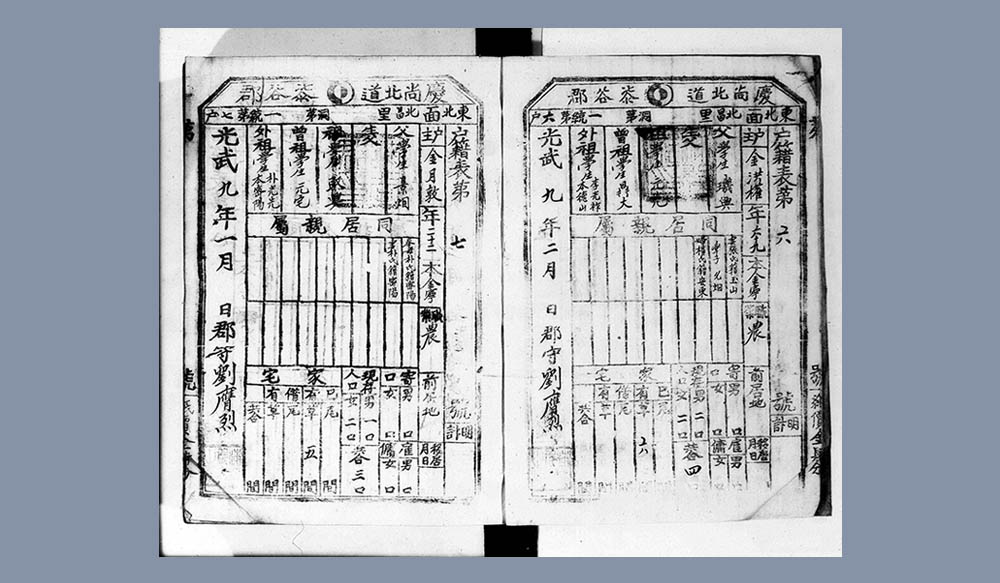
18. Korean Census Records. 1834-1907.
These are two microfilm sets of Korean census records from 1834 to the 1930s. The originals are kept respectively in the Institute for Research in Humanities of Kyoto University and the Gakushuin University Library. The acquisition of these two sets was a collaborative effort among faculty, librarians and library administrations at UCI, Kyoto and Gakushuin, Korea.
c. A sample household record from Koseiki Daicho shows not only all people residing in the household and their kinship relations, but also house type, number of rooms and the number of domestic workers. It may also reveal residence address changes, if any.
戶籍大帳 Koseki Daicho. Korea: Publisher Unknown. January 1834 - January 1902.
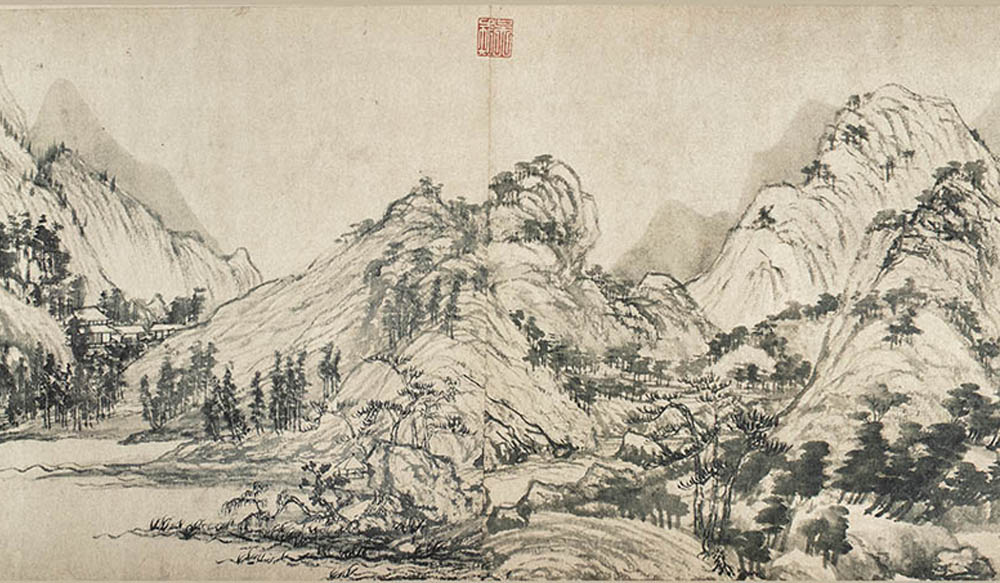
19. China’s Yuan Dynasty Scroll Painting. Huang Gongwang. 富春山居圖 Fuchun Shan Ju Tu (Dwelling in the Fuchun Mountains). Publisher and publication date unknown. UCI Libraries’ Special Collections and Archives.
A facsimile of Fuchun Shan Ju Tu 富春山居圖 (Dwelling in the Fuchun Mountains) by Huang Gongwang 黃公望 (1269-1354), a great painter, poet and scholar from ancient China. He was considered the greatest of the Four Masters (outstanding artists) of the Yuan Dynasty. Dwelling in the Fuchun Mountains depicts the mountain and river scenery near the painter’s residence.
This painting is one of Huang’s few surviving works. In 1651, this painting was burnt into two pieces. One piece, the shorter one, is now held at Zhejiang Provincial Museum in Hangzhou, and the second piece is housed in the National Palace Museum in Taipei. Item is a facsimile of the second, longer piece.



















Introduction - Birth and Growth (Items 1-12) - Rare and Precious Resources (Items 13-19)
Books are for Use (Items 20-31) - Resources for the Local Community (Items 32-41) - Grants and Gifts (Items 42-49)
Working with Global Partners to Build the Collection (Items 50-56) - With the Help of Faculty and Friends (Items 57-62)
Autographed Books and Tributes (Items 63-72)
Questions? Please contact us at partners@uci.edu. Copyright Statement.


